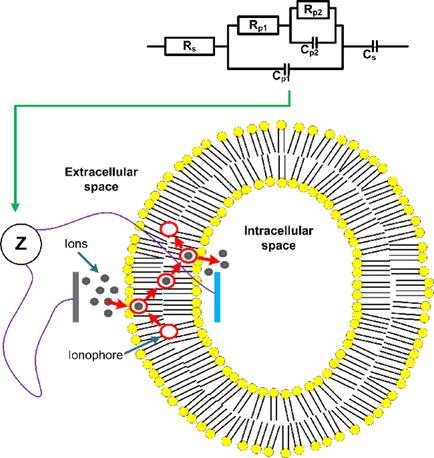当前位置:
X-MOL 学术
›
Electroanalysis
›
论文详情
Our official English website, www.x-mol.net, welcomes your
feedback! (Note: you will need to create a separate account there.)
Model Biological Membranes and Possibilities of Application of Electrochemical Impedance Spectroscopy for their Characterization
Electroanalysis ( IF 2.7 ) Pub Date : 2017-12-21 , DOI: 10.1002/elan.201700649 Štěpánka Skalová 1, 2 , Vlastimil Vyskočil 2 , Jiří Barek 2 , Tomáš Navrátil 1
Electroanalysis ( IF 2.7 ) Pub Date : 2017-12-21 , DOI: 10.1002/elan.201700649 Štěpánka Skalová 1, 2 , Vlastimil Vyskočil 2 , Jiří Barek 2 , Tomáš Navrátil 1
Affiliation

|
Biological membranes are essential parts of living systems. They represent an interface between intracellular and extracellular space. Depending on their structure, they often perform very complex functions and play an important role in the transport of both charged and uncharged particles in any organism. Structure of the biological membranes, which play very important role in electrochemical processes inside living organisms, is very complicated and still not precisely defined and explained. Model lipid membranes are used to gain detail information about properties of real biological membranes and about associated electrochemical processes. Electrochemistry, especially electrochemical impedance spectroscopy (EIS), can play a useful role in the characterization of properties of model lipid membranes (planar and supported lipid bilayers, tethered lipid membranes, liposomes, etc.). This review is focused on model biological membranes and the possibilities and limitations of electrochemical methods and namely of EIS in this field.
中文翻译:

模型生物膜及其在电化学阻抗谱分析中应用的可能性
生物膜是生命系统必不可少的部分。它们代表细胞内和细胞外空间之间的界面。根据它们的结构,它们通常执行非常复杂的功能,并在任何生物体中带电和不带电粒子的运输中发挥重要作用。生物膜的结构在生物体内的电化学过程中起着非常重要的作用,它的结构非常复杂,至今仍未精确定义和解释。模型脂质膜用于获得有关实际生物膜的特性以及相关的电化学过程的详细信息。电化学,尤其是电化学阻抗谱(EIS),在表征模型脂质膜(平面和支持的脂质双层,系留脂质膜,脂质体等)。这项审查集中在模型生物膜和电化学方法的可能性和局限性,即在该领域的EIS。
更新日期:2017-12-21
中文翻译:

模型生物膜及其在电化学阻抗谱分析中应用的可能性
生物膜是生命系统必不可少的部分。它们代表细胞内和细胞外空间之间的界面。根据它们的结构,它们通常执行非常复杂的功能,并在任何生物体中带电和不带电粒子的运输中发挥重要作用。生物膜的结构在生物体内的电化学过程中起着非常重要的作用,它的结构非常复杂,至今仍未精确定义和解释。模型脂质膜用于获得有关实际生物膜的特性以及相关的电化学过程的详细信息。电化学,尤其是电化学阻抗谱(EIS),在表征模型脂质膜(平面和支持的脂质双层,系留脂质膜,脂质体等)。这项审查集中在模型生物膜和电化学方法的可能性和局限性,即在该领域的EIS。











































 京公网安备 11010802027423号
京公网安备 11010802027423号